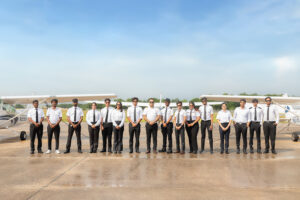
From getting a medical certificate to the number of flying hours, all is governed by the Federal Aviation Administration (FAA), being the overseeing authority. This blog will outline the modalities of obtaining a license and the major steps toward fulfilling your dream of flying an airplane.
Understanding Pilot Licenses
If you want to become a pilot in the US, you should first acquaint yourself with the Types of Pilot Licenses. Every license provided has its regulations and approvals.
- Private Pilot License (PPL): This is the first license that you will receive. It is legal for you to fly for other purposes but not for business or financial gains.
- Commercial Pilot License (CPL): As you hold this license, you are paid the opportunity to fly. It requires more lessons and flight hours than any study of the PPL.
- Airline Transport Pilot License (ATPL): This is the greatest level of achievement in pilot certification. It is necessary for pilots who desire to be captains of airlines.
- Instrument Rating (IR): This rating allows a pilot to operate under special meteorological conditions—it is so crucial in flying, especially in less-than-favorable conditions.
- Multi-Engine Rating (MEL): This is useful when operating aircraft that have more than one engine because there are many in commercial operations.
Eligibility Requirements
The next step toward piloting a commercial plane is something that you ought to fulfill as per the rules and regulations given by the Federal Aviation Administration. These include:
- You must be at least 17 years old to qualify for a Private Pilot License (PPL), 18 years old for a Commercial Pilot License (CPL), and over 21 years old for an Airline Transport Pilot License (ATPL).
- You must take a medical examination (Class I and II).
- Good knowledge of English, both spoken and written, is required.
- Basic vision and hearing standards are mandatory for servicemen.
How to Become a Professional Pilot in the US?
There are programs, commitments, and certain regulatory standards that one has to meet if he or she is to be a professional pilot in the United States. Here’s a simple guide to the steps you need to take to achieve your dream of flying for a living:
Step 1: Obtain a private pilot license (PPL)
The first one is acquiring an FAA Private Pilot License. You are given the minimum understanding and ability to operate an aircraft with a single engine. You shall undergo both aerodrome and flight training and even tests; you only need to do classroom training and tests online and then apply your knowledge in flight practice.
Step 2: Get an Instrument Rating (IR)
Then follows Instrument Rating, which is denoted as IR. This enables you to fly during fog and other poor weather conditions under some directions (IFR stands for Instrument Flight Rules). It is a good milestone when going from flying at one’s bell to flying for sales.
Step 3: Obtain a Commercial Pilot Licence (CPL)
If you get a Commercial Pilot License (CPL), you can work as a professional pilot. You will learn more and get more practical experience. As for this license, you have to complete the stabilized flight time.
Step 4: Obtain a Multi-Engine Rating (ME rating)
In order to further your flying abilities, you might want to take the CPL holder through a multi-engine rating (MEL). This, for example, allows you to fly planes with more than one engine, making you more versatile as a pilot.
Step 5: Get your Certified Flight Instructor (CFI) rating
A CFI teaches others how to fly airplanes; it helps you gain more flight hours while earning your wage. This is the first step before getting an Airline Transport Pilot (ATP), which you need 500 hours if you want to be approved as a pilot.
Step 6: Start Your Career
After that, you can either begin your career and fly as a commercial pilot for an airline after accumulating the required flight hours and other specifications.
Cost of Becoming a Pilot
Being a pilot may be one of the amazing career aspects; however, it is also a challenging undertaking as it demands both time and capital. Approximations suggest that the total expense for a learner to cover all the training is between $6500 and $75000 in the United States. They are based on the fact that the student has no prior flying experience at all.
Training takes approximately a year and covers LPC and CPL stages starting from the Private Pilot Licence. It depends on the flight school, the number of hours required to complete the training, and the costs of exams and other necessary procedures. As for the financial factor, training to become a pilot is manageable in terms of time, but it is pricey nonetheless.
Accumulating Flight Hours for Employment Opportunities
The next step is to get flight hours so as to be able to meet the requirements of a commercial airline pilot. In the USA, for example, the pilot is required to complete at least 500 flight hours to meet the standards of any airline. This may sound like a tall order, but many attain additional hours by investing in their PPL by becoming a CFI or flying for a cargo airline.
Such jobs create opportunities for pilots to be paid while they gain experience in flying, thereby minimizing the costs. Learning while earning can be beneficial to a pilot, especially when it comes to enhancing their career experience.
Salary Expectations of Airline Pilots
Pilot training can be very expensive, but once a person begins to fly as a pilot, the income can be lucrative. The median salary for airline pilots last year was $2,160 to $3,360 monthly. Such a salary represents the demands for the qualification and determination needed to become a commercial airline pilot. This way, the income potential of the investment into flight training is promising for those individuals willing to devote their efforts to that profession.
